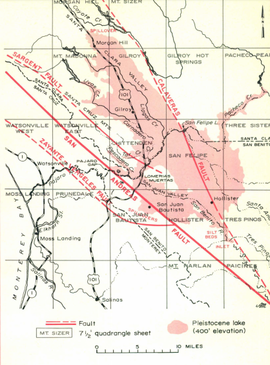Difference between revisions of "Pajaro River"
(→Issues) |
(→Tributaries) |
||
| Line 8: | Line 8: | ||
== Tributaries == | == Tributaries == | ||
| + | Upper watershed tributaries are the San Benito River, Tres Pinos Creek, the overflow of San Felipe Creek from Pacheco and Santa Ana Creeks, LLagas Creek, Carnadero Creek, Tar Creek and Pescadero Creek.<ref name = “PLEISTOCENE LAKE"/> | ||
== Hydrology == | == Hydrology == | ||
Revision as of 15:55, 4 April 2018
Contents
Location
The Pajaro River drains a watershed of 1,300 square miles in Santa Cruz, Santa Clara, San Benito, and Monterey Counties.
History

Today the Pajaro River flows in an artificial channel designed by the Army Corps of Engineers from San Benito, Santa Cruz, and Monterey counties discharging out into the Monterey Bay. The modern Pajaro River channel meets the historical Corralitos Creek channel, evolving Corralitos Creek into a tributary. This river is unique as the San Andres Fault continuously changes its path from as far south as the Elkhorn Slough to as far north as its current mouth at Corralitos Creek.[2] During the Pleistocene, landslides at the Pajaro Gap prevented flow resulting in what’s referred to as San Benito Lake east of the San Andres Fault extending as far north as Morgan Hill and eastward past Hollister. While this lake was held back at the Pajaro Gap, there was some spillover south into the Elkhorn Valley. More recently, landslides in that region have caused the formation of smaller lakes such as Soda Lake which is now a Pleistocene remnant. Today the Pajaro River flows freely past the Pajaro Gap and into the Pajaro Valley.[1] During early statehood, there was a ranchero that possibly channelized the lower Pajaro to reclaim the land. It was in 1948 that the U.S. Army Engineers completed the levee channel system on what is now the modern day flow of the river. [2]
Tributaries
Upper watershed tributaries are the San Benito River, Tres Pinos Creek, the overflow of San Felipe Creek from Pacheco and Santa Ana Creeks, LLagas Creek, Carnadero Creek, Tar Creek and Pescadero Creek.[1]
Hydrology
Public Access
Issues
- Flooding
- Levee system
- Water quality
References
- ↑ 1.0 1.1 1.2 Ca Geology. July 1973. “PLEISTOCENE LAKE SAN BENITO” [4 April 2018]. Volume 26:7. Available from: ftp://ftp.conservation.ca.gov/pub/dmg/pubs/cg/1973/26_07.pdf
- ↑ 2.0 2.1 Watershed Institute. July 22, 2003. Pájaro River Watershed Flood Protection Plan. [4 April 2018]. Available from: http://www.pajarowatershed.org/archive/uploads/Flood%20Protection/Watershed%20Studies/Curry%20Flood%20Protection%20Plan%202003.pdf
Links
- Pajaro Valley
- Pajaro Valley Groundwater Overdraft Concerns
- Hollister Hills State Vehicular Recreation Area (SVRA)
- California's Central Coast Region
Disclaimer
This page may contain students' work completed as part of assigned coursework. It may not be accurate. It does not necessarily reflect the opinion or policy of CSUMB, its staff, or students.